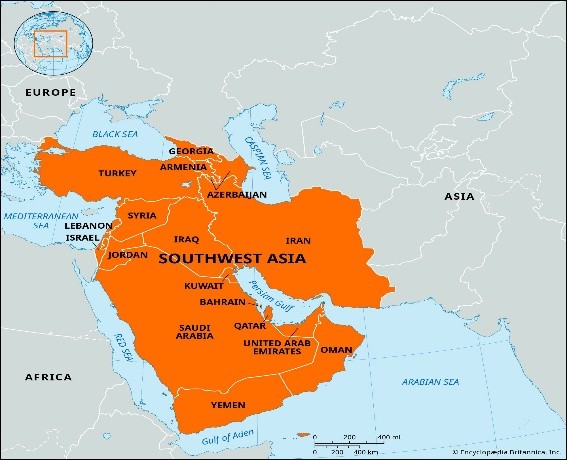Reshaping Energy and Geopolitics in West Asia

- 24 Jun 2025
In News:
The geopolitical landscape of West Asia is undergoing a profound transformation driven by escalating conflicts, realignments of power, and the increasing weaponisation of energy. The Israel-Iran conflict, rising threats to critical maritime routes, and the shifting allegiances of Gulf states are redefining the region’s strategic and energy equations, with direct implications for global stability and India’s national interests.
West Asia’s Centrality to Global Energy Security
- The Gulf region holds over 50% of global proven oil reserves, producing around 33% of the world’s oil and 17% of global natural gas.
- Despite a global shift to renewables, the world still consumes ~100 million barrels of oil daily, with ~50% used for transport and ~20% for petrochemicals.
- Natural gas accounts for 23% of global energy consumption, supplying a quarter of global electricity.
Geopolitical Flashpoints: Conflict and Energy Disruption
- Israel’s airstrikes on Iran’s nuclear facilities and Iran’s missile retaliation have heightened the risk of regional war.
- Iran may block the Strait of Hormuz, through which ~20% of global oil trade passes. Even the threat has increased insurance and freight rates.
- Charter costs for Very Large Crude Carriers (VLCCs) from the Gulf to China have risen from ~$20,000 to ~$48,000 per day.
- Iran’s oil exports (~2 million barrels/day) form ~2% of global oil supply, difficult to replace due to limited spare capacity among other producers.
- Threat of attacks on energy infrastructure by Iran-backed militias adds to regional instability.
Strategic Realignments in West Asia
- Gulf states (Saudi Arabia, UAE, Qatar) are moving toward multi-polar engagements, strengthening ties with China and Russia, and reducing dependence on the US.
- Historical precedent: The 1973 Arab oil embargo demonstrated the region's ability to influence global politics through oil.
- Arab monarchies’ reluctance to support Western-backed regime change in Iran stems from fears of regional destabilisation and domestic backlash.
- Public sentiment in Gulf nations remains strongly pro-Palestinian and anti-Western, adding internal pressures on ruling elites.
Weaponisation of Energy as a Strategic Tool
- The use of oil embargoes or supply disruptions is re-emerging as a geopolitical instrument.
- Iran could resort to asymmetric warfare or encourage proxy attacks on rival oil facilities, particularly in Iraq (which produces over 4 million barrels/day) and the Gulf.
Implications for India
Opportunities:
- Scope to diversify energy suppliers and enhance strategic petroleum reserves (SPR).
- India’s position in BRICS and SCO offers diplomatic space to act as a moderating influence.
Risks:
- 40–50% of India’s energy imports transit through the Strait of Hormuz—any disruption threatens energy security.
- Surging oil prices can fuel imported inflation, impacting transport, agriculture, and industrial costs.
- Indian projects like Chabahar Port, the International North-South Transport Corridor (INSTC), and the India-Middle East-Europe Corridor (IMEC) face operational uncertainties.
- Strain on India’s balanced ties with Israel and Iran, with diplomatic fallout possible.
- Gulf remittances (a vital source of foreign exchange) may decline if regional conflict escalates.
Conclusion
West Asia’s reconfiguration is a reminder of the enduring nexus between energy and geopolitics. For India, navigating this complex terrain requires strategic autonomy, energy diversification, and robust regional diplomacy. Balancing relations amid shifting alliances, while securing national interests in energy and trade, must remain central to India’s foreign policy calculus.
